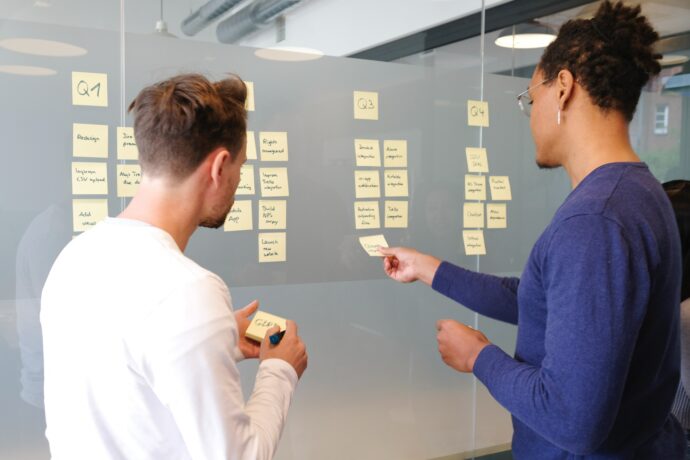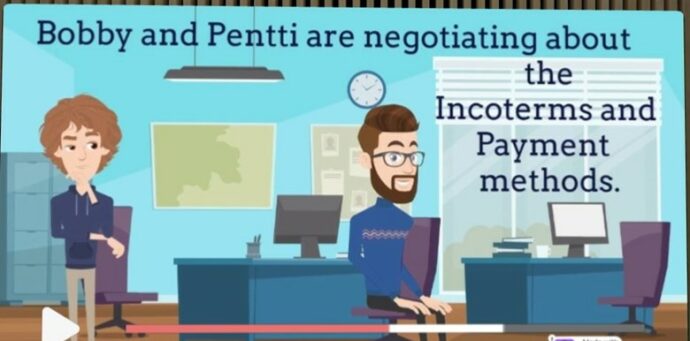Scenario-based e-learning presents learners with a hypothetical work scenario, where they make decisions and are shown the consequences. This kind of method is well suited to learning on the job. It develops different skills, such as critical thinking and problem-solving, and allows learners to make mistakes in a safe, risk-free environment. Making mistakes during the exercises is seen as a learning experience rather than a negative thing. When mistakes are made, learners can correct their own performance immediately based on the feedback. (Brandt 2022; Clark 2009; Clark & Mayer 2012; Kindley 2002; Richter 2019.) Scenario-based microlearning, as the name suggests, combines these two learning strategies (Galhotra 2020). In the VIVA research, development and innovation (RDI) project, the problems of international real-life business cases were developed into virtual reality micro-scenarios.
 Photo by Airfocus on Unsplash
Photo by Airfocus on Unsplash
In scenario-based learning, learners actively participate throughout the process (Kolinski 2022). Scenarios are made of four elements: people performing the task at hand, on-the-job setting, a real-world challenge and the consequence or the feedback of the choice or action (eLearningArt 2022). Scenario-based learning provides an opportunity for active learning. The learner’s choices have an impact on the outcome. It is also suitable for situations where there is no single right answer. (Clark & Mayer 2012.)
A good scenario motivates, challenges and rewards the learner. Scenarios can be used to practice broad areas of knowledge or individual skills. A scenario can also be created as an entire learning pathway, containing micro-scenarios. (Brandt 2022; Kindley 2002; Richter 2019.) The short and simple design of microlearning makes the scenarios easy to understand for learners. This helps employees better retain the information they learn.
Storytelling with scenario-based e-learning makes the learning experience compelling and meaningful to the learner. Storytelling is effective, as it places learners in situations they would really encounter in their daily job. It also creates relatable characters that learners easily build emotional connection with. This means that it drives user engagement and increases knowledge retention. (Richter 2019; Vojnovski 2021.)
The VIVA case of delivery of technical equipment from Finland to England
The purpose of the VIVA – Virtual Technologies Boost SME Exports project, funded by the Helsinki–Uusimaa Regional Council, is to provide SMEs with a new way to simulate and practice export trade interactions. The project encounters export trade, modern technologies and continuous learning. Modern technologies refer to Augmented Reality (AR) and Virtual Reality (VR). (Heiskanen & Kuhmonen 2021.)
The VIVA project focuses on the skills development of small and medium-sized companies (SMEs) and designing learning for their purposes. Scenario-based microlearning in virtual reality was tested as a possible learning strategy for continuous learning at work. England as a target market came up in VIVA project team’s needs discussions with SMEs from the perspective of how Brexit has impacted exports from Finland.
The VIVA case was about the transport of technical equipment from Finland to England. Brexit has had some impact on exports from Finland to England. The UK has left the European Union’s single market and customs union, which means that customs and regulatory procedures apply to goods being exported from Finland to the UK. This has increased administrative burdens and additional costs related to customs clearance and compliance with new regulatory requirements.
The co-creation process involved a London-based business representative, VIVA project team, a logistics expert and an international team of Laurea UAS’ business students with the instructor-lecturer. Business students operate in the peer-to-peer (P2P) learning environment, and the VIVA RDI project was integrated to their service business studies. The learning objectives included: 1. How do exports of technical equipment from Finland outside the European Union differ from intra-EU trade? 2. What should the exporter negotiate with the buyer regarding the delivery? 3. What risks might realize in the supply chain and how to protect from them?
The scenarios were developed through several rounds of iterations and testing. When developing a learning environment consisting of scenarios, it is recommended that the scenarios are sufficiently realistic (Learning Everest 2022; Pandey 2019). The pre-defined choices included the place of departure and destination of the delivery, as well as the size, value and quantity of the goods.
The scenarios were instructed to be designed in such a way that as they progress, the learners must make different choices, for example choose a suitable mode of transport, right Incoterms and payment method. As a result of the choices made, it is possible to see what would happen if the risks realized. The risks included delayed delivery, damaged goods due to bad weather conditions and lost transport documents, among other things. Animated videos were used for storytelling in the scenarios.
 Figure 1: An animation scenario in the VIVA’s ”Export outside EU” environment.
Figure 1: An animation scenario in the VIVA’s ”Export outside EU” environment.
The following issues were considered when assessing the functionality and appropriateness of the scenarios:
- Are the learning objectives achievable?
- Are the scenarios sufficiently realistic?
- Are the scenarios credible? Are they plausible enough to create a realistic chain of events?
- Are the choices made feasible, i.e., can they be made in real life?
Highlights of the learning journey
The final outcome of this agile co-creation experiment was different versions of a visual story in the form of micro-animations about the delivery of goods from Finland to England and the impact of the choices made by the exporter. The risks that materialized were similar to those that could occur in a real-life export operation.
The challenge of co-developing scenarios for the VIVA’s ”Export outside EU” virtual reality environment was above all that the students had to absorb a huge amount of information in a short period of time to understand the real problems of exporting companies and design realistic scenarios that meet companies’ needs. From the pedagogical point of view, this can also be seen as a benefit, as the co-development of scenarios allowed students for rapid learning curves.
According to the experience of the VIVA team, it is difficult to bridge the skills gap between students who are just getting their first taste of the subject and those experts who work daily in the export business – at least to the extent that a single student project lasting a few months would result in scenarios that would be of real use to the company’s personnel and that would allow them to practice the skills needed in demanding decision-making situations. On the other hand, students have the strength of innovative and creative thinking from a clean slate and questioning things, which in the best case produces alternative, out-of-the-box, solutions to real-life problems.
The key takeaways from the VIVA team’s scenario-based microlearning journey can be summarized in the following recommendations:
- Understand learners’ needs.
- Define learning objectives according to the learners’ needs.
- Design scenarios relevant to learners’ job roles, industry, and skill levels.
- Ensure that learners can apply their knowledge and skills to solve real-world problems.
- Encourage learners to seek, evaluate and apply new information to support their decision-making.
- Let learners fail.
- Apply storytelling.
- Adopt user-friendly technologies that are accessible on various devices.
- Provide adequate feedback to help learners understand their strengths and areas of improvement.
- Evaluate the effectiveness periodically by collecting feedback from the learners.
According to the VIVA project team’s observations, one of the weaknesses of the scenario-based microlearning is that it provides limited feedback for improvement of performance, which can hinder learning and development. The learning experience cannot be tailored for each learner, which limits its effectiveness. The VIVA’s ”Export outside EU” virtual reality environment could be further developed by increasing the learner’s ability to make choices. More effective use of microlearning could improve better learner engagement and learning outcomes.
VIVA project team highlights that if businesses want to get the most out of this learning strategy, they need to invest enough time in developing varied scenarios that offer sufficient options and feedback, and in continuously evaluating the effectiveness of the scenarios based on feedback from learners. If the development of scenarios is outsourced, for example to students, sufficient interaction and an iterative approach to development is needed.
In conclusion, scenario-based microlearning can be an effective training method for SMEs in the export industry, provided that it is well-designed, relevant, interactive, and engaging. It is essential to understand the learners’ needs, select the right technology, provide adequate feedback, and evaluate the effectiveness of the program periodically to ensure its success.
Sources:
- Brandt, L. 2022. Scenario-Based Learning: What It Is and How It Works? Retrieved: 7.12.2022.
- Clark, R. 2009. Accelerating expertise with scenario based learning. Learning Blueprint. Merrifield, VA: American Society for Teaching and Development.
- Clark, R. & Mayer, R. 2012. Scenario-based e-Learning: Evidence-Based Guidelines for Online Workforce Learning. Retrieved: 7.12.2022.
- eLearningArt. 2022. Scenario-based eLearning Examples, Expert Tips, and How-to. Retrieved: 7.12.2022.
- Galhotra, A. 2020. What Makes Scenario-Based Microlearning Content Cutting-Edge? E-learning industry. Retrieved: 13.4.2023.
- Heiskanen, M. & Kuhmonen, A. 2021. Tietoja. Retrieved: 24.4.2023.
- Kindley, R. W. 2002. Scenario-based e-learning: a step beyond traditional e-learning. ASTD Magazine. Retrieved: 7.12.2022.
- Kolinski, H. 2022. Scenario-Based Learning 101: Beginner’s Guide. Retrieved: 7.12.2022.
- Learning Everest. 2022. Scenario-based Learning Examples. Retrieved: 7.12.2022.
- Pandey, A. 2019. A 5-Step Plan To Create A Captivating Scenario-Based Corporate Training. Retrieved: 7.12.2022.
- Richter, D. 2019. Storytelling With Scenario-Based eLearning: Why It’s Not Just For Books. Retrieved: 7.12.2022.
- Vojnovski, T. 2021. How Creative Storytelling Brings Interactive Scenario-Based Learning Experiences To Life. Retrieved: 7.12.2022.